Accepted Scientific Name: Crassula barbata Thunb.
Nova Acta Phys.-Med. Acad. Caes. Leop.-Carol. Nat. Cur. 6: 329 1778
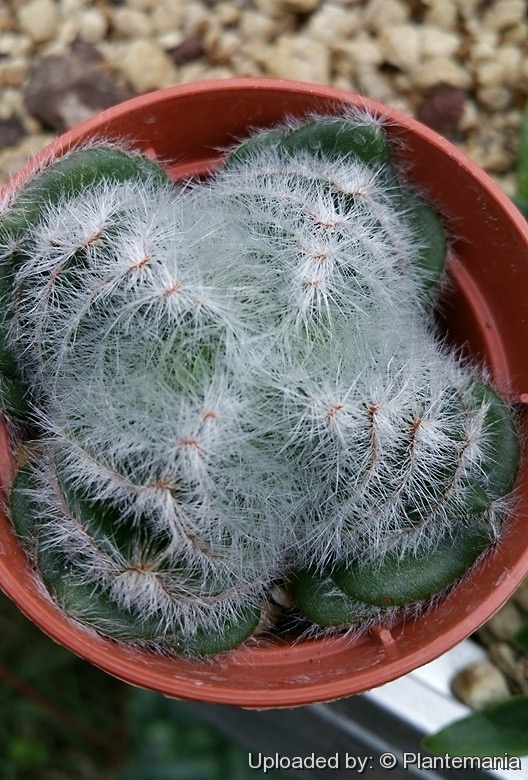
Purgosea barbata (Crassula barbata) Photo by: © Plantemania
Origin and Habitat: Crassula barbataSN|26830]]SN|26830]] is common and widely distributed in South-western Great Karoo to Prince Albert, also Victoria West in the central karoo. South Africa
Habitat: It grows among rocks always under bushes.
Synonyms:
See all synonyms of Crassula barbata
back
Accepted name in llifle Database:Crassula barbata Thunb.Nova Acta Phys.-Med. Acad. Caes. Leop.-Carol. Nat. Cur. 6: 329 1778Synonymy: 3
Accepted name in llifle Database:Crassula barbata subs. broomii (Schönland) ToelkenJ. S. African Bot. 41: 97 1975Synonymy: 2
back
Common Names include:
ENGLISH: Bearded-leaved Crassula
AFRIKAANS (Afrikaans): Baardrosie
DANISH (Dansk): Skægget Krassula
Description: Crassula barbataSN|26830]]SN|26830]] (Bearded Leaved Crassula) is a biennial or annual rosette-forming succulent species up to a span high when flowering, usually with one rosette with leaves spirally arranged and old ones remaining attached to stems. Leaves are glabrous but characteristically bearded along the truncate apex with long white spreading hairs. The spikes of small, white to pinkish flowers appear in spring. The rosette will open up as the centre extends to form the tall flower stem, and after flowering it will die. Fortunately the dying rosette usually produces a number of basal rosettes which can be detached and grown on to repeat the cycle.
Rosette: Basal, 30-40 mm in diameter usually solitary, or proliferating from the base to form small groups.
Leaves: Very thin, scarcely succulent, numerous, connate in opposite pairs, hemispherically imbricate and arranged in four overlapping ranks, (10-)25-35(50) mm long and (10-)15-35(-40) mm broad, soft, green to grey-green, erect or spreading, with a spathulate petiole, expanding into a shortly obovate or cuneate-flabelliform lamina, rounded to abruptly cut off at top, dorsiventrally flattened, glabrous and fringed with conspicuous rigid marginal hairs 4-8 mm long, membranous when dry. The surface of the leaves is able to absorb whatever moisture reaches them in the form of dew or mist and a leaf may absorb in a single night more water in this way than it loses by transpiration in a week.. The shape and size of the leaves of this species are often variable within the same population, but there is a tendency towards narrow leaves eastwards towards Prince Albert. Throughout the range the species is, however, easily distinguished by the very long marginal cilia which are often clustered into groups, particularly in the Cedarberg.
Inflorescence (spike-like thyrse): Flowers stem glabrous 15-30 cm tall, slightly angular, erect, simple but sometimes branched, more than half of it occupied by the spiked inflorescence, with opposite subdistant leaf-scales below, angular, floriferous above. Cymules capitato-fasciculate, 12-25 mm apart, sessile in the axils of opposite, scale-like bracts, forming a long spicate-thyrsus with sessile flowers with indistinct peduncle covered with leaflike bracts gradually decreasing upwards.
Flowers: Sepals short, ovate to blong-triangular, 2,5-3 mm long, nerved, glabrous except for few marginal cilia, fleshy, green. Corolla tubular, fused basally for 1-1,5 mm, white to dark pink. Petals connate at base, oblong, sub-spathulate, suberect with recurved points 3,5-5,5 mm long . Stigma almost sessile and broad. Stamens 3-4.5 mm, anthers black.
Chromosome number: 2n = 14 and have large chromosomes.
Subspecies, varieties, forms and cultivars of plants belonging to the Crassula barbata group
 Crassula barbata Thunb.: (subsp. barbata) has solitary rosettes with very long marginal cilia often clustered into groups. Distribution: Prince Albert along the Karoo mountains to the eastern Cedarberg.
Crassula barbata Thunb.: (subsp. barbata) has solitary rosettes with very long marginal cilia often clustered into groups. Distribution: Prince Albert along the Karoo mountains to the eastern Cedarberg. - Crassula barbata subs. broomii (Schönland) Toelken: has leaves are 30-40 mm long, 20-35 mm broad, with much shorter cilia (less than 1 mm). Distribution: recorded only from near Victoria West.
Bibliography: Major references and further lectures
1) Edgar Lamb, Brian Lamb “The Illustrated Reference on Cacti & Other Succulents” Volume 5 Blandford Press, 1978
2) Edgar Lamb, Brian Lamb “The Illustrated Reference on Cacti & Other Succulents” Volume 5 Blandford Press, 1978
3) Werner Rauh “The Wonderful World of Succulents: Cultivation and Description of Selected Succulent Plants Other Than Cacti” Smithsonian Institution Press, 1984
4) Doreen Court “Succulent Flora of Southern Africa” CRC Press, 01/Jun/2000
5) Stuart Max Walters “The European Garden Flora: Dicotyledons” (Part I) Cambridge University Press, 1989
6) Gordon D. Rowley “The illustrated encyclopedia of succulents” Crown Publishers, 01/Aug/1978
7) Gordon Rowley “Crassula: A Grower's Guide” Cactus & Company, 2003
8) Eggli, Urs “Illustrated Handbook of Succulent Plants, Crassulaceae Illustrated Handbook of Succulent Plants.” Springer, Berlin 2002
9) Hermann Jacobsen “Abromeitiella to Euphorbia” Blandford Press, 1960
10) Hermann Jacobsen “A handbook of succulent plants: descriptions, synonyms, and cultural details for succulents other than Cactaceae” Volume 1 Blandford Press, 1960
11) Toelken, H.R. 1997. “A revision of the genus Crassula” in southern Africa. Annals of the Bolus Herbarium 8,1-595.
12) Van Jaarsveld, E., Van Wyk, B-E. & Smith, G. “Succulents of South Africa.” Tafelberg, Cape Town. 2000
13) John Wilkes “Encyclopaedia Londinensis” Volume 5 1810
14) John Manning “Field Guide to Fynbos” Struik, 2007
15) Christopher Brickell “RHS Encyclopedia of Plants and Flowers” Dorling Kindersley Ltd, 01/set/2010
16) Otto A. Leistner “Flora of southern Africa” 1985
17) George Don “A General History of the Dichleamydeous Plants ... Arranged According to the Natural System”, Volume 3 J. G. and F. Rivington, 1834
18) Alfred Byrd Graf “Exotica, series 4 international: pictorial cyclopedia of exotic plants from tropical and near-tropic regions” Roehrs Co. Publishers, 1985
19) The National Cactus and Succulent Journal: The Official Journal of the National Cactus & Succulent Society, Volumes 31-34 National Cactus and Succulent Society, 1976
20) Dr J.P. Roux “Flora of South Africa” 2003
21) W. H. Harvey “Flora Capensis” Vol 2, 1894
 Purgosea barbata (Crassula barbata) Photo by: Giuseppe Distefano
Purgosea barbata (Crassula barbata) Photo by: Giuseppe Distefano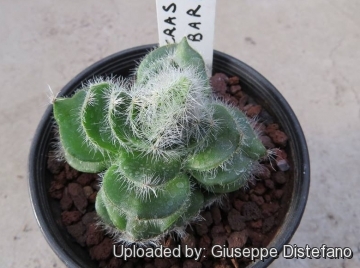 Purgosea barbata (Crassula barbata) Photo by: Giuseppe Distefano
Purgosea barbata (Crassula barbata) Photo by: Giuseppe Distefano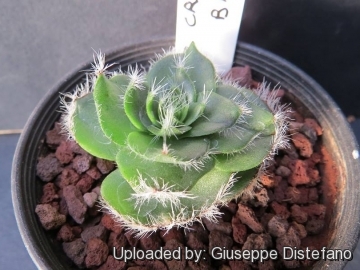 Purgosea barbata (Crassula barbata) Photo by: Giuseppe Distefano
Purgosea barbata (Crassula barbata) Photo by: Giuseppe Distefano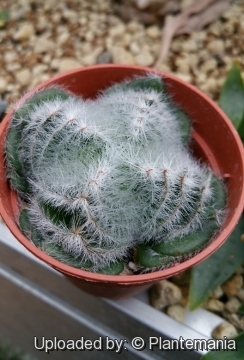 Purgosea barbata (Crassula barbata) Photo by: © Plantemania
Purgosea barbata (Crassula barbata) Photo by: © Plantemania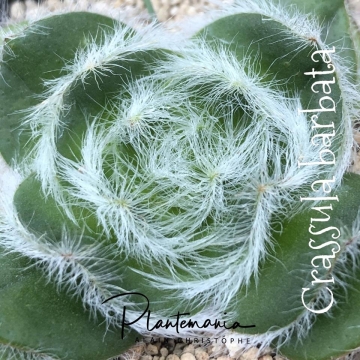 Purgosea barbata (Crassula barbata) Photo by: © Plantemania
Purgosea barbata (Crassula barbata) Photo by: © PlantemaniaSend a photo of this plant.The gallery now contains thousands of pictures, however it is possible to do even more. We are, of course, seeking photos of species not yet shown in the gallery but not only that, we are also looking for better pictures than those already present.
Read More... Cultivation and Propagation: Crassula barbataSN|26830]]SN|26830]] is a one of the most frustrating species to grow, but properly grown, in a compost that is not too rich, in a good light, and not overwatered, a single rosette will become a beautiful sight as the leaves curve inwards and the plant assumes the appearance of a hairy ball.
They are often grown in small bonsai pots.
Growth rate: It is a pretty fast grower.
Soil: Plants grow well in a well-drained mineral soil.
Pots: It needs a relatively shallow pot to accommodate its fibrous roots and provide a very good drainage.
Exposure: It cannot take direct sun in summer, too much sunshine and the leaves will scorch, but generally needs sun part of the day to bloom. In deep shade it gets pretty weak and eventually rots and dies. As houseplants, give crassulas up to 6 hours a day of sun.
Watering: It needs moderate water – not too wet nor too dry from autumn to spring with regular water in summer (careful watering required in winter), insufficient water and they will shrivel; too much water and the rosette will open up into a hairy cabbage.
Fertilization: Light fertilizer seems to boost its growth whenever additional water is given. Feed it during the growing season with a fertilizer specifically formulated for cactus and succulents (high potash fertilizer with a dilute low nitrogen), including all micro nutrients and trace elements diluted to ½ the strength recommended on the label. It thrive in poor soils and needs a limited supplies of fertilizer to avoid the plant developing excess vegetation, which is easily attacked by fungal diseases.
Special need: Provide very good ventilation. Nearly all problems occur as a result of overwatering and poor ventilation, especially when weather conditions are dull and cool or very humid.
Pest and diseases: It does not suffer from pests, other than the occasional mealybugs. Protect against frost.
Hardiness: Outdoors in frost free areas, indoors all other zones.
Propagation: Seeds/ Offsets. Sow seeds in autumn. Place cuttings in clean river sand, mist every three to four days, roots should appear within 2-3 weeks.















